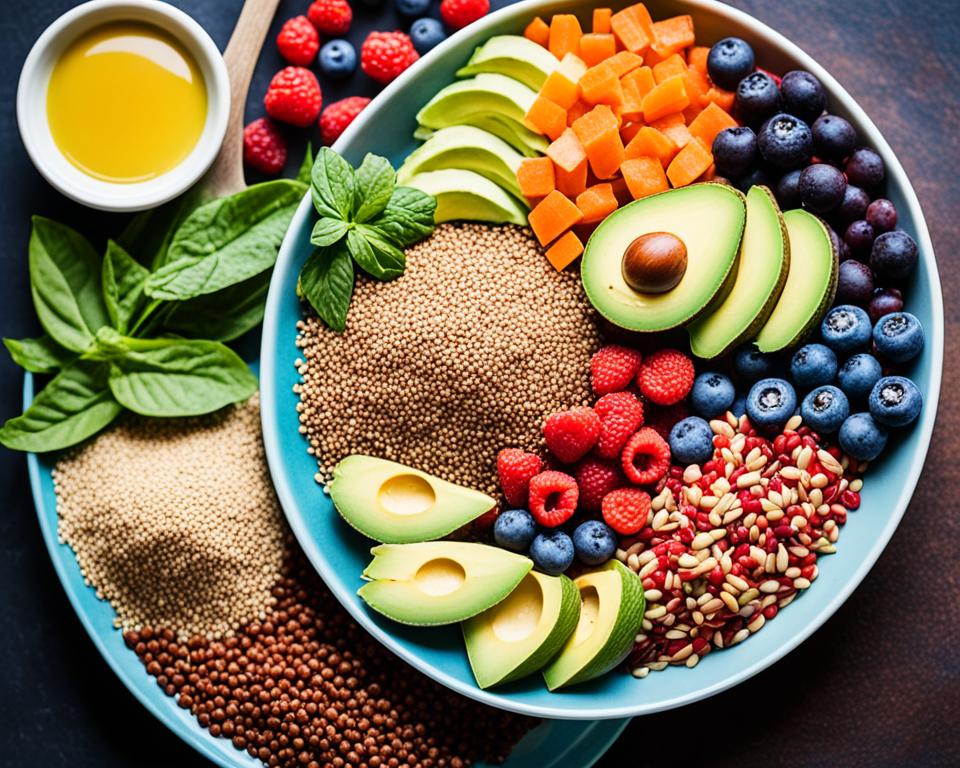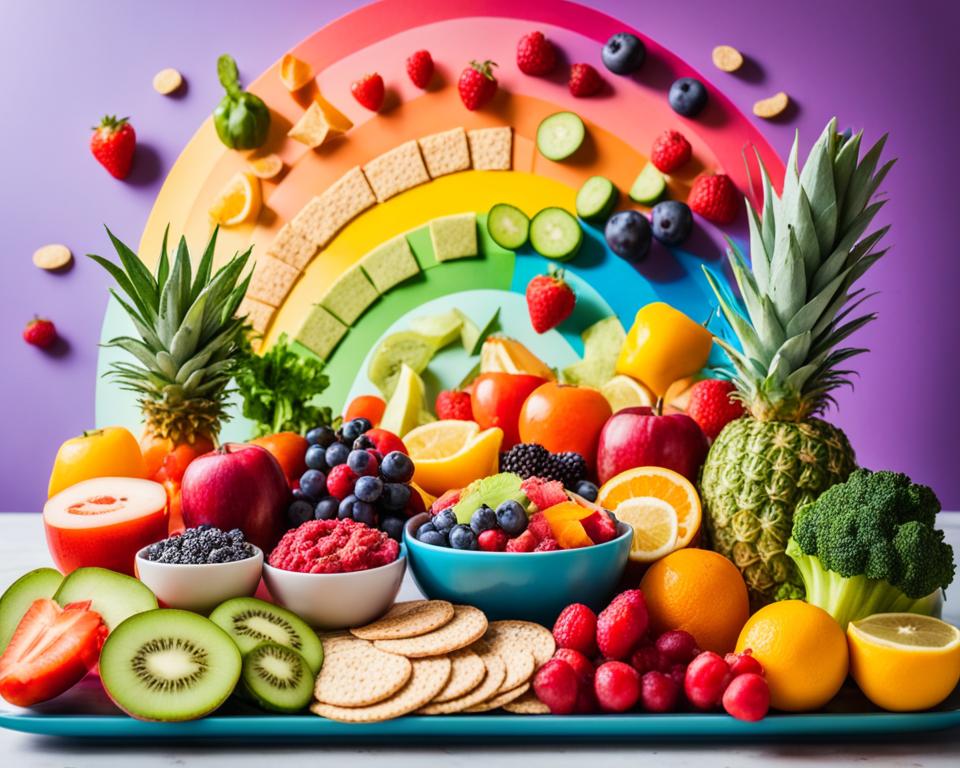When it comes to making healthier dietary choices, many people are opting for gluten-free and sugar-free options. Whether it’s due to dietary preferences, allergies, or a desire to improve overall health, there is a growing demand for allergen-friendly menus and alternatives to gluten and sugar. Fortunately, there are plenty of delicious and nutritious options available that cater to these needs.
Key Takeaways:
- Gluten-free and sugar-free options are becoming more popular as people seek to meet their dietary preferences and needs.
- Reducing or avoiding sugary drinks, candy, desserts, and other sweets is a more realistic goal than completely eliminating sugar from the diet.
- Many nutritious and tasty foods are both gluten-free and sugar-free, providing a wide range of options for those following these dietary restrictions.
- Consulting with a registered dietitian can help ensure a well-balanced diet while maintaining a gluten-free and sugar-free lifestyle.
- Incorporating regular exercise alongside a healthy diet is essential for overall health and wellbeing.
Understanding Gluten-Free and Sugar-Free Diets
When it comes to dietary preferences, many individuals opt for gluten-free and sugar-free options. Understanding what these diets entail is essential for making informed choices. Gluten, a protein found in wheat, rye, and barley, is commonly avoided by those with celiac disease or gluten intolerance. On the other hand, sugar is naturally present in various foods like fruit, vegetables, and dairy products.
For individuals looking to limit their sugar intake, it’s important to be aware of the difference between natural sugars and added sugars. While natural sugars found in whole, unprocessed foods are generally considered healthy, added sugars can be detrimental to overall health. When it comes to gluten-free and sugar-free foods, it’s crucial to focus on options that are not only free from these ingredients but also meet nutritional needs.
Gluten-Free Options
Foods that are gluten-free include fruits and vegetables, plain frozen vegetables, animal and vegetable proteins, plain unflavored dairy products, gluten-free grains, and some beverages like plain black coffee and certain teas. For those following a gluten-free diet, it’s important to read food labels carefully to avoid hidden sources of gluten, such as malt, dextrin, and modified food starch. Choosing gluten-free alternatives for bread and pasta that are high in fiber and free from unhealthy fillers is also advisable.
Sugar-Free Alternatives
When it comes to reducing sugar consumption, whole, unprocessed foods like fruits, plain yogurt, and milk are ideal choices. It’s important to note that while many healthy foods contain natural sugars, it’s the added sugars in processed foods and beverages that should be avoided. By opting for sugar-free alternatives, individuals can still enjoy sweet flavors without the negative health effects.
| Foods to Include | Foods to Avoid |
|---|---|
|
|
Understanding the distinction between gluten-free and sugar-free options is crucial for individuals with specific dietary preferences. By focusing on whole, unprocessed foods and making mindful choices, individuals can follow a gluten-free and sugar-free diet while still enjoying delicious and nutritious meals.
The Benefits of Avoiding Gluten and Sugar
Avoiding gluten is crucial for individuals with celiac disease, an autoimmune condition that causes adverse reactions to gluten consumption. Research has shown that people with celiac disease can experience gastrointestinal harm when they consume gluten. Furthermore, those who are intolerant or sensitive to gluten may also encounter various symptoms such as abdominal pain, joint and muscle pain, fatigue, and depression.
On the other hand, reducing the intake of added sugar in the diet is a wise strategy to avoid excessive empty calories and limit the consumption of foods with minimal nutritional benefits. This can be particularly beneficial for individuals aiming to lose weight, as it helps to reduce calorie intake. People with diabetes also benefit from curbing added sugars, although it is important to note that moderate amounts of sugar from nutritious foods containing natural sugars can still be incorporated into their carbohydrate targets.
By consciously avoiding gluten and sugar, individuals can support their overall health and well-being. Following gluten-free and sugar-free dietary preferences can help alleviate symptoms associated with celiac disease, gluten intolerance, and sugar sensitivity. It also promotes a balanced and nutrient-rich eating pattern.
It’s essential to consult a healthcare professional or registered dietitian for personalized guidance and support in making these dietary changes.
Gluten-Free Diet Tips
Transitioning to a gluten-free diet can be challenging, but with the right knowledge and guidance, it’s entirely manageable. Here are some helpful tips to navigate this dietary shift:
1. Read Food Labels Carefully
When following a gluten-free diet, it’s crucial to carefully read food labels to avoid hidden sources of gluten. Ingredients such as malt, dextrin, modified food starch, and brown rice syrup could contain traces of gluten, so it’s important to be diligent in checking labels.
2. Choose High-Fiber Gluten-Free Breads and Pastas
While removing gluten from your diet, it’s essential to ensure you’re still getting enough fiber. Look for gluten-free breads and pastas that are high in fiber and free from unhealthy fillers. This will help maintain digestive health and provide satisfying meals.
3. Consult with a Registered Dietitian
Seeking guidance from a registered dietitian specialized in gluten-free diets can be immensely helpful. They can provide personalized advice, recommend gluten-free alternatives, and ensure your diet remains well-balanced and nutritious.
4. Explore Gluten-Free Recipes and Alternatives
Embrace the opportunity to discover new ingredients and try out gluten-free recipes. There are countless online resources available that offer a wide range of delicious gluten-free options. Experiment with alternative flours, such as almond or coconut flour, to create gluten-free versions of your favorite dishes.
5. Emphasize Whole, Unprocessed Foods
When adopting a gluten-free diet, focus on incorporating whole, unprocessed foods into your meals. This includes plenty of fruits, vegetables, lean proteins, and gluten-free grains. By prioritizing these nutrient-dense options, you’ll ensure you’re nourishing your body while avoiding gluten.

| Gluten-Free Alternatives | Main Benefits |
|---|---|
| Quinoa | High in fiber, protein, and essential nutrients |
| Almond Flour | Rich in healthy fats and adds a delightful nutty flavor to baked goods |
| Coconut Flour | Gluten-free and provides a moist texture to baked goods |
| Brown Rice | Nutritious alternative to wheat-based grains |
| Tapioca Starch | Used as a thickener and adds texture to gluten-free recipes |
By incorporating these gluten-free alternatives into your diet, you’ll have a variety of delicious options to choose from while maintaining a balanced and gluten-free lifestyle.
Sugar-Free Diet Tips
Reducing added sugars in your diet can have numerous health benefits. Currently, food labels do not differentiate between natural and added sugars. However, starting in July 2018, all food labels will list the amount of added sugars along with total sugars, making it easier for you to make informed choices. Here are some tips to help you follow a sugar-free diet:
Check Ingredient Labels
To limit added sugars, it’s important to carefully check ingredient labels for hidden sources. Look out for words ending in -ose, such as sucrose, fructose, and maltose, as these indicate added sugars. Additionally, ingredients labeled as syrups can also indicate the presence of added sugars.
Beware of Hidden Sugars
Added sugars can often be found in unexpected places, such as salad dressings, pasta sauces, and canned fruit. These hidden sugars can add up quickly, so it’s important to read labels and choose products with little to no added sugars.
Moderation is Key
While it’s important to reduce or eliminate added sugars, it’s also essential to practice moderation. Cutting out all sugars completely is not necessary or practical. Instead, focus on reducing your overall intake of added sugars while still enjoying sugar-free alternatives and naturally sweet foods like fruits.
Opt for Sugar-Free Alternatives
When cravings for something sweet strike, there are plenty of sugar-free alternatives that you can indulge in. Look for sugar-free desserts and snacks that use natural sweeteners like stevia or erythritol. There are also many sugar-free recipes available online that use these alternatives to create delicious treats.
“Reducing added sugars in your diet can have a positive impact on your overall health. By choosing sugar-free alternatives and being mindful of hidden sugars, you can enjoy a diet that is lower in added sugars and still satisfies your sweet tooth.”
To help you navigate the world of sugar-free options, here is a table highlighting some common sugar-free alternatives:
| Sugar-Free Alternatives | Description |
|---|---|
| Stevia | A natural sweetener derived from the stevia plant. It has zero calories and does not raise blood sugar levels. |
| Erythritol | A sugar alcohol that contains very few calories and does not affect blood sugar levels. It is often used in sugar-free candies and desserts. |
| Monk fruit extract | A natural sweetener derived from the monk fruit. It contains zero calories and does not affect blood sugar levels. |
| Artificial sweeteners | These are calorie-free or low-calorie sugar substitutes that provide sweetness without raising blood sugar levels. Examples include aspartame, sucralose, and saccharin. |
| Fruit | Naturally sweet fruits like berries, apples, and oranges can satisfy your sweet cravings while providing beneficial nutrients and fiber. |
By incorporating these sugar-free alternatives into your diet and being mindful of hidden sugars, you can reduce your intake of added sugars and enjoy a healthier, sugar-free lifestyle.
Gluten-Free and Sugar-Free Snack Ideas
When it comes to snacks, there are plenty of gluten-free and sugar-free options available. Focusing on whole foods and choosing snacks made with real, unprocessed ingredients is key. Here are some healthy snack ideas to satisfy your cravings:
- Fresh fruits: Enjoy a variety of seasonal fruits, such as berries, apples, and oranges, for a naturally sweet and nutritious snack.
- Vegetables: Chop up some crunchy vegetables like carrot sticks, cucumber slices, and bell pepper strips. Pair them with a flavorful hummus for added taste.
- Nuts and seeds: Almonds, walnuts, pumpkin seeds, and sunflower seeds make for a satisfying and protein-packed snack.
- Gluten-free granola bars: Look for gluten-free options that are low in added sugars and high in fiber for a convenient and tasty snack on the go.
- Homemade trail mix: Mix together your favorite gluten-free nuts, seeds, and dried fruits in a delicious trail mix that you can customize to your taste.
- Greek yogurt with berries: Enjoy a bowl of creamy Greek yogurt topped with fresh berries for a protein-rich and refreshing snack.
- Rice cakes with avocado: Spread mashed avocado on top of gluten-free rice cakes for a satisfying and nutrient-dense snack.
If you’re looking for more snack ideas, you can explore numerous gluten-free and sugar-free recipes available online. From delicious energy balls to homemade kale chips, there are endless possibilities to satisfy your cravings while sticking to your dietary preferences.
The Importance of a Balanced Diet
While it is important to choose gluten-free and sugar-free options, it is equally important to maintain a balanced and nutrient-dense diet. A balanced diet ensures that your body receives the necessary nutrients to support overall health and wellbeing.
A balanced diet includes a variety of healthy food options such as:
- Fruits and vegetables: Rich in vitamins, minerals, and antioxidants.
- Lean proteins: Chicken, fish, tofu, and legumes provide essential amino acids for muscle repair and growth.
- Whole grains: Quinoa, brown rice, and oats are high in fiber and provide sustained energy.
- Healthy fats: Avocado, nuts, and olive oil contain heart-healthy fats that support brain function and reduce inflammation.
A balanced diet not only includes gluten-free and sugar-free options but also focuses on nutrient-dense foods. Nutrient-dense foods provide a high amount of essential nutrients with relatively low calories. These foods are rich in vitamins, minerals, and antioxidants, supporting overall health and wellbeing.
Consulting with a registered dietitian can help ensure that you are getting all the necessary nutrients while following a gluten-free and sugar-free diet. A dietitian can provide personalized guidance and help you create a balanced meal plan tailored to your dietary needs.
Quote:
“A balanced diet is not a short-term fix, but a lifelong commitment to nourishing your body and supporting optimal health.” – Nutritionist Sarah Thompson
To further emphasize the importance of a balanced diet, consider the following table showcasing the nutrient composition of common gluten-free and sugar-free food options:
| Food Option | Calories | Protein (g) | Fat (g) | Carbohydrates (g) | Fiber (g) | Vitamins & Minerals |
|---|---|---|---|---|---|---|
| Grilled Chicken Breast (3 oz) | 142 | 26 | 3 | 0 | 0 | Vitamin B6, Iron |
| Brown Rice (1 cup) | 216 | 5 | 2 | 45 | 3 | Fiber, Magnesium |
| Spinach (1 cup) | 7 | 1 | 0 | 1 | 1 | Vitamin K, Folate |
| Avocado (1 medium) | 234 | 3 | 21 | 12 | 10 | Vitamin C, Vitamin E, Potassium |
| Raspberries (1 cup) | 64 | 1 | 0 | 15 | 8 | Vitamin C, Manganese |
By incorporating a balance of nutrient-dense foods into your gluten-free and sugar-free diet, you can optimize your health and enjoy a variety of delicious meals.
The Importance of Exercise
Alongside a healthy diet, regular exercise is key to maintaining overall health and wellbeing. Engaging in physical activity not only helps to manage weight and prevent chronic conditions, but it also boosts mood and energy levels. For those following a gluten-free and sugar-free diet, incorporating exercise into their daily routine can further enhance the benefits of their dietary choices.
Physical activity is an essential component of a healthy lifestyle. It promotes cardiovascular health, strengthens muscles and bones, and improves flexibility and balance. Regular exercise can also contribute to maintaining a healthy weight, reducing the risk of obesity and related health conditions such as diabetes and heart disease.
For individuals on a gluten-free and sugar-free diet, exercise can play a crucial role in achieving optimal health. It not only supports weight management but also helps to regulate blood sugar levels and improve insulin sensitivity.
Various forms of exercise can be suitable for individuals following a gluten-free and sugar-free diet. Brisk walking, jogging, cycling, and swimming are excellent options for cardiovascular fitness. Strength training with bodyweight exercises or weights can help build muscle and increase metabolism. Yoga and other flexibility exercises can improve balance, promote relaxation, and enhance overall well-being.

Exercise is like an all-natural antidepressant. It releases endorphins, improves mood, and reduces stress and anxiety.
In addition to the physical benefits, exercise also has a positive impact on mental health. It releases endorphins, which are known as “feel-good” hormones, improving mood and reducing stress and anxiety. Regular physical activity can also enhance cognitive function, memory, and overall brain health.
When incorporating exercise into a gluten-free and sugar-free lifestyle, it is essential to listen to your body and choose activities that you enjoy. Finding a workout routine that fits your schedule and preferences will increase adherence and make exercise a sustainable part of your lifestyle.
In conclusion, exercise is a crucial component of a healthy lifestyle, especially for individuals following a gluten-free and sugar-free diet. It provides numerous physical and mental health benefits, enhances the effects of a healthy diet, and contributes to overall well-being.
Dining Out with Dietary Restrictions
When it comes to dining out with specific dietary restrictions, such as the need for allergen-free, gluten-free, or sugar-free options, it can sometimes feel challenging to find suitable choices on the menu. However, with the increasing awareness of dietary preferences and restrictions, many restaurants now offer menus that cater to these needs.
Restaurant Tips:
- Call Ahead: To ensure that a restaurant can accommodate your dietary preferences, it is advisable to call ahead and inquire about their menu options. This way, you can have a better understanding of what choices are available and make an informed decision about where to dine.
- Online Research: Another useful tip is to research the menu online before visiting a restaurant. This allows you to review the menu in advance and identify any potential gluten-free or sugar-free options that may be available.
- Communicate Your Needs: When you arrive at the restaurant, don’t hesitate to communicate your dietary preferences and restrictions to your server or chef. By clearly expressing your needs, you can work together to ensure that your meal is prepared according to your requirements.
“Many restaurants now offer menus that cater to allergen-free, gluten-free, and sugar-free dietary preferences, making it easier to enjoy a satisfying meal while adhering to your specific needs.”
By following these restaurant tips, you can enhance your dining experience and enjoy a delicious meal that aligns with your dietary preferences. Remember, it is essential to advocate for yourself and communicate your needs to ensure a safe and enjoyable dining experience at any restaurant you visit.
Making Gluten-Free and Sugar-Free Choices Easy
Making healthy choices and following a gluten-free and sugar-free diet can be easy with a little bit of planning and preparation. Here are some tips to help you navigate your way to a more wholesome lifestyle:
1. Meal Planning:
Meal planning is a great tool to ensure that you have nutritious meals and snacks on hand, making it less tempting to reach for unhealthy options. Set aside some time each week to plan your meals, create a grocery list, and prepare healthy recipes. This will not only save you time and money, but it will also help you stay on track with your gluten-free and sugar-free goals.
2. Stock Up on Gluten-Free and Sugar-Free Ingredients:
Having a well-stocked pantry and refrigerator filled with gluten-free and sugar-free ingredients can make it easier to stick to your dietary goals. Stock up on whole grains like quinoa and brown rice, lean proteins like chicken and fish, fresh fruits and vegetables, and natural sweeteners like stevia and monk fruit. Having these ingredients readily available will make it easier to prepare delicious and nutritious meals without compromising your dietary needs.
3. Experiment with New Recipes:
Transitioning to a gluten-free and sugar-free lifestyle doesn’t mean giving up your favorite dishes. Explore new recipes and find healthier alternatives that satisfy your cravings. There are plenty of gluten-free and sugar-free recipes available online that can help you discover new flavors and techniques. From savory main courses to indulgent desserts, you’ll be surprised at the variety of delicious options available.
4. Find Healthy Substitutes:
Instead of feeling deprived, focus on finding healthy substitutes for your favorite gluten-containing and sugary foods. For example, opt for cauliflower rice instead of traditional rice, almond flour instead of wheat flour, and zucchini noodles instead of pasta. There are also plenty of sugar-free alternatives to satisfy your sweet tooth, such as using fruit purees or natural sweeteners in your baking. Get creative and explore the world of gluten-free and sugar-free cooking.
5. Stay Mindful and Enjoy the Process:
“Eating well is a form of self-love.”
Remember that making healthy choices is a journey, not a destination. Embrace the process and enjoy discovering new flavors and nourishing your body with wholesome foods. Practice mindful eating by savoring each bite, listening to your body’s hunger and fullness cues, and being present in the moment. By staying mindful, you’ll truly appreciate the benefits of your gluten-free and sugar-free lifestyle.
| Benefits of Making Gluten-Free and Sugar-Free Choices | Healthy Eating Tips |
|---|---|
| 1. Supports weight management | 1. Choose whole, unprocessed foods |
| 2. Promotes gut health | 2. Incorporate fruits and vegetables |
| 3. Reduces inflammation | 3. Opt for lean proteins |
| 4. Enhances energy levels | 4. Limit processed and packaged foods |
| 5. Supports overall well-being | 5. Stay hydrated |
The Importance of Mindful Eating
Mindful eating is an essential component of a healthy lifestyle. It involves being present and fully engaged while consuming food, paying attention to your body’s hunger and fullness cues, and savoring the flavors and textures of your meals. This practice allows you to develop a deeper connection with your body and make choices that align with your dietary preferences and needs.
When following a gluten-free and sugar-free diet, it becomes even more important to listen to your body and make mindful decisions. By tuning in to how different foods make you feel, you can tailor your meals and snacks to support your overall wellbeing. Intuitive eating is a helpful approach to foster this awareness and help you become more in tune with your body’s signals.
“The first step to mindful eating is to listen to your body. It knows what it needs.” – Author Unknown
Listening to your body means being aware of your hunger and fullness levels. It means acknowledging when you are satisfied and honoring that feeling by stopping eating. It also means recognizing when you are truly hungry and nourishing yourself with wholesome foods.
Practicing mindful eating can have numerous benefits. By slowing down and savoring each bite, you may find that you naturally eat less and feel more satisfied. This can help prevent overeating and promote healthier food choices. Mindful eating can also enhance your overall enjoyment of meals, allowing you to fully appreciate the flavors and textures of your food.
When it comes to gluten-free and sugar-free options, mindful eating can help you make informed decisions. By paying attention to how different foods impact your body, you can identify which options align best with your dietary needs and preferences. This thoughtful approach can empower you to create a balanced and nourishing diet that supports your overall health and wellbeing.
| Benefits of Mindful Eating |
|---|
| Enhanced appreciation for food |
| Better portion control |
| Reduced emotional eating |
| Improved digestion |
| Increased satisfaction with meals |
Practicing mindful eating is a journey that takes time and patience. It involves being fully present during meals, avoiding distractions, and truly focusing on the experience of eating. By cultivating this awareness, you can develop a healthier relationship with food and make choices that support your gluten-free and sugar-free lifestyle.
Remember, each individual’s dietary needs and preferences are unique. By listening to your body and practicing mindful eating, you can create a personalized approach to gluten-free and sugar-free options that works best for you.
Conclusion
In conclusion, incorporating gluten-free and sugar-free options into a healthy lifestyle can support individuals with specific dietary preferences or restrictions. With a wide variety of delicious and nutritious choices available, individuals can enjoy meals and snacks that align with their dietary needs while promoting overall health and wellbeing.
By focusing on whole, unprocessed foods and making mindful choices, individuals can create a balanced diet that includes gluten-free and sugar-free options. Choosing fresh fruits, vegetables, lean proteins, and gluten-free grains ensures a nutrient-rich approach to eating. Limiting added sugars and opting for natural sources of sweetness helps reduce empty calories and maintain a sugar-free diet.
Consultation with a registered dietitian or healthcare professional can further enhance the journey towards incorporating gluten-free and sugar-free choices. These experts can provide personalized guidance, support, and education to ensure a well-rounded and sustainable dietary plan.
Embracing a gluten-free and sugar-free lifestyle is a step towards taking control of one’s health and dietary preferences. By making informed choices and seeking professional assistance when needed, individuals can enjoy a balanced, flavorful, and fulfilling diet that supports their overall wellbeing.
FAQ
What are gluten-free and sugar-free options?
Gluten-free and sugar-free options refer to foods and ingredients that do not contain gluten or added sugars. These options are suitable for individuals with dietary restrictions or preferences.
Why would someone choose a gluten-free and sugar-free diet?
Individuals may choose a gluten-free and sugar-free diet for various reasons, including health concerns, dietary restrictions, or personal preferences.
What foods are gluten-free and sugar-free?
Foods that are gluten-free and sugar-free include fruits, vegetables, plain meats, Greek yogurt, gluten-free grains, and certain beverages like plain black coffee and some teas.
Why should someone avoid gluten?
Avoiding gluten is necessary for individuals with celiac disease, an autoimmune disease that can cause harm to the gastrointestinal system when gluten is consumed. Some people with gluten intolerance or sensitivity may also experience symptoms when they consume gluten.
How can I ensure a well-balanced gluten-free diet?
To ensure a well-balanced gluten-free diet, it is important to read food labels carefully, choose gluten-free products that are high in fiber and free from unhealthy fillers, and consult with a registered dietitian for guidance on dietary changes.
Why is it important to reduce added sugars?
Reducing added sugars is beneficial for weight management, diabetes management, and overall health. Added sugars are often found in processed foods and provide empty calories without significant nutritional value.
How can I identify hidden sugars in food products?
Hidden sugars can be identified by checking ingredient labels for words ending in -ose and ingredients labeled as syrups. It is also important to be aware of hidden sugars in salad dressings, pasta sauces, and canned fruit.
What are some gluten-free and sugar-free snack ideas?
Some gluten-free and sugar-free snack ideas include fresh fruits, vegetables, nuts, seeds, gluten-free granola bars, homemade trail mix, Greek yogurt with berries, hummus with carrot sticks, and rice cakes with avocado.
Is it important to maintain a balanced diet while following a gluten-free and sugar-free lifestyle?
Yes, it is important to maintain a balanced diet by including a variety of fruits, vegetables, lean proteins, whole grains, and healthy fats in your meals. Consulting with a registered dietitian can help ensure you are getting all the necessary nutrients.
How does exercise complement a gluten-free and sugar-free diet?
Regular exercise is important for overall health and wellbeing. Incorporating physical activity into your routine can enhance the benefits of a gluten-free and sugar-free diet, helping to manage weight, prevent chronic conditions, and boost mood and energy levels.
How can I find gluten-free and sugar-free options when dining out?
Many restaurants now offer allergen-friendly menus or have options for those with dietary restrictions. Calling ahead or researching the menu online can help ensure there are suitable options available. Communicating your dietary preferences to the server or chef is also helpful.
How can I make gluten-free and sugar-free choices easier?
Planning meals in advance, stocking your pantry with gluten-free and sugar-free ingredients, and experimenting with new recipes can make it easier to make healthier choices. Consulting with a registered dietitian can also provide guidance and support.
What is mindful eating and how does it relate to a gluten-free and sugar-free lifestyle?
Mindful eating involves paying attention to your body’s hunger and fullness cues, as well as savoring and enjoying your food. Practicing intuitive eating can help you make mindful choices that align with your gluten-free and sugar-free lifestyle.





